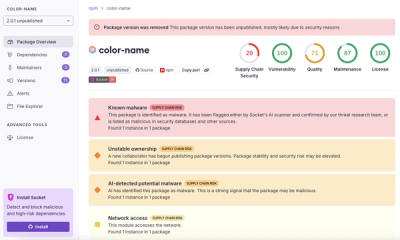
Research
/Security News
npm Author Qix Compromised via Phishing Email in Major Supply Chain Attack
npm author Qix’s account was compromised, with malicious versions of popular packages like chalk-template, color-convert, and strip-ansi published.
@workday/canvas-colors-web
Advanced tools
Canvas colors values in web formats.
The base Canvas color palette is available in CommonJS, ES6, JSON, LESS, and SASS formats.
Colors (100-600):
The default import will provide hex color values as strings. Colors are accessed via their camel-cased names (e.g. frenchVanilla100).
TypeScript types are provided for convenience.
ES6 exports are located in @workday/canvas-colors-web/dist/es6.
import colors from '@workday/canvas-colors-web'
colors.frenchVanilla100
CommonJS exports are located in @workday/canvas-colors-web/dist/commonjs.
const colors = require('@workday/canvas-colors-web')
colors.frenchVanilla100
To access HSLA, import from canvas-colors.js from your preferred JS format folder.
import colors from '@workday/canvas-colors-web/dist/es6/canvas-colors.js'
const colors = require('@workday/canvas-colors-web/dist/commonjs/canvas-colors.js')
colors.frenchVanilla100
Import Paths
SASS variable sheets are located in @workday/canvas-colors-web/dist/sass. They are available as both .sass and .scss.
canvas-colors-hex.scsscanvas-colors-rgba.scsscanvas-colors.scssColor variables are camel-cased.
@import '@workday/canvas-colors-web/dist/sass/canvas-colors-hex.scss';
$wdc-color-french-vanilla-100;
Import Paths
LESS variable sheets are located in @workday/canvas-colors-web/dist/less.
canvas-colors-hex.lesscanvas-colors-rgba.lesscanvas-colors.lessColor variables are camel-cased.
@import '@workday/canvas-colors-web/dist/sass/canvas-colors-hex.less';
@wdc-color-french-vanilla-100;
To ensure consistency across implementations, our semantic constants should be used wherever possible. This allows us to swap out the color of a button or icon for example, without having to find every instance of it and change the color manually.
We have several semantic groupings:
commonColorsbuttonColors
deleteprimarysecondaryiconColorsstatusColorstypeColorsJS
import { iconColors } from '@workday/canvas-colors-web'
iconColors.hover
SCSS
@import '@workday/canvas-colors-web/dist/sass/canvas-colors-hex.scss';
$wdc-color-common-background;
LESS
@import '@workday/canvas-colors-web/dist/sass/canvas-colors-hex.scss';
@wdc-color-common-background;
The charting color palette is a set of 86 colors from the Canvas palette. Colors should be used in incremental numerical order. Offsets should also be used depending on the chart type. Color access keys start at 1 and go up to 86.
Offsets:
JS
import { chartingColors, chartingColorOffsets } from '@workday/canvas-colors-web'
chartingColors[1]
chartingColors[chartingColorOffsets.barAndColumn + i]
SCSS
@import '@workday/canvas-colors-web/dist/sass/canvas-colors-hex.scss';
$wdc-color-charting-1;
$wdc-color-bar-and-column;
LESS
@import '@workday/canvas-colors-web/dist/sass/canvas-colors-hex.scss';
@wdc-color-charting-1;
@wdc-color-bar-and-column;
(c) Workday, Inc.
FAQs
Canvas colors for web
The npm package @workday/canvas-colors-web receives a total of 1,348 weekly downloads. As such, @workday/canvas-colors-web popularity was classified as popular.
We found that @workday/canvas-colors-web demonstrated a not healthy version release cadence and project activity because the last version was released a year ago. It has 6 open source maintainers collaborating on the project.
Did you know?

Socket for GitHub automatically highlights issues in each pull request and monitors the health of all your open source dependencies. Discover the contents of your packages and block harmful activity before you install or update your dependencies.

Research
/Security News
npm author Qix’s account was compromised, with malicious versions of popular packages like chalk-template, color-convert, and strip-ansi published.

Research
Four npm packages disguised as cryptographic tools steal developer credentials and send them to attacker-controlled Telegram infrastructure.

Security News
Ruby maintainers from Bundler and rbenv teams are building rv to bring Python uv's speed and unified tooling approach to Ruby development.